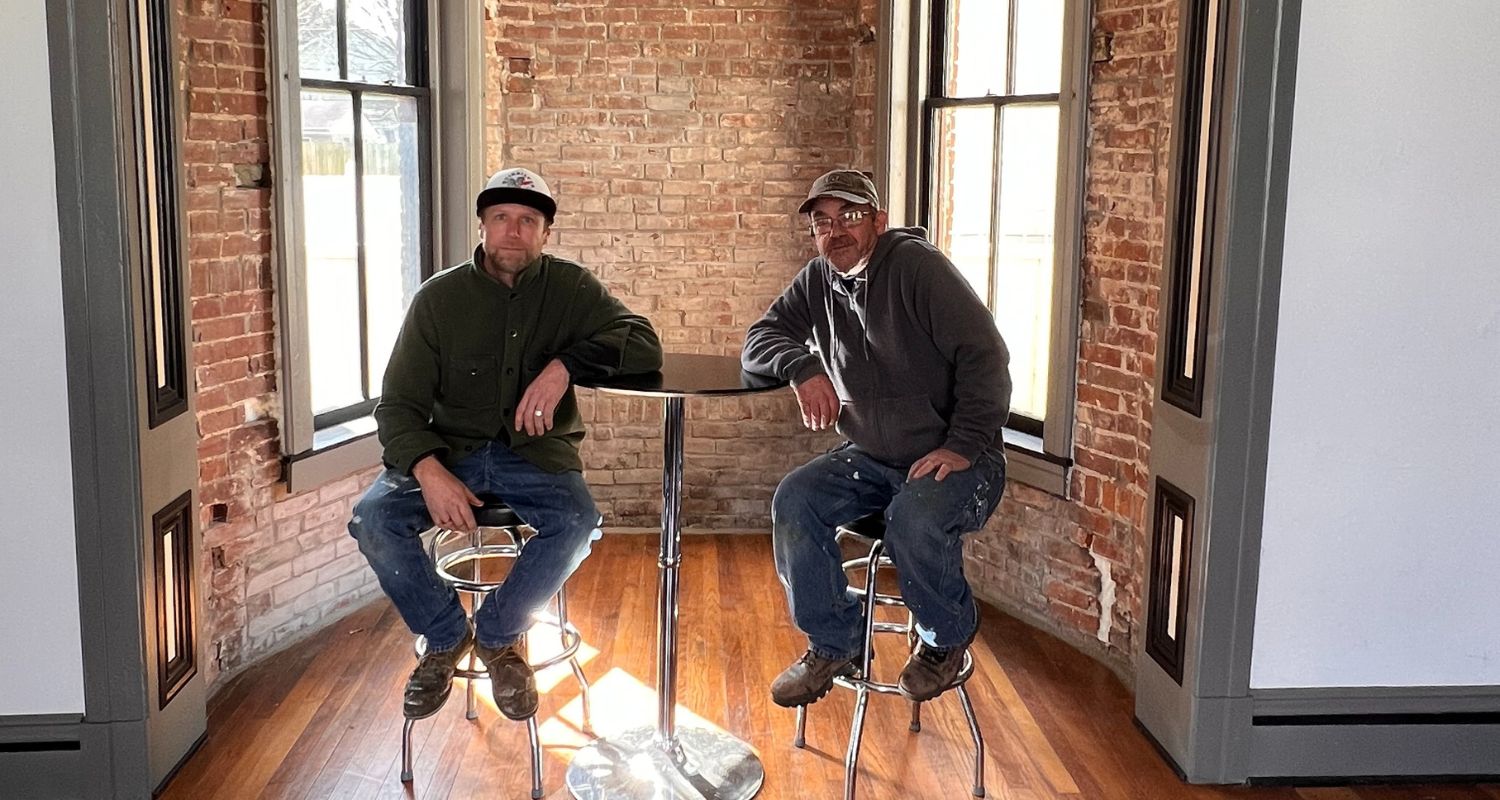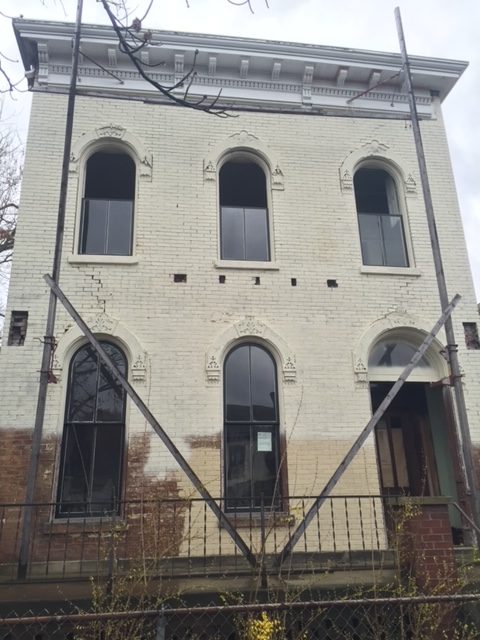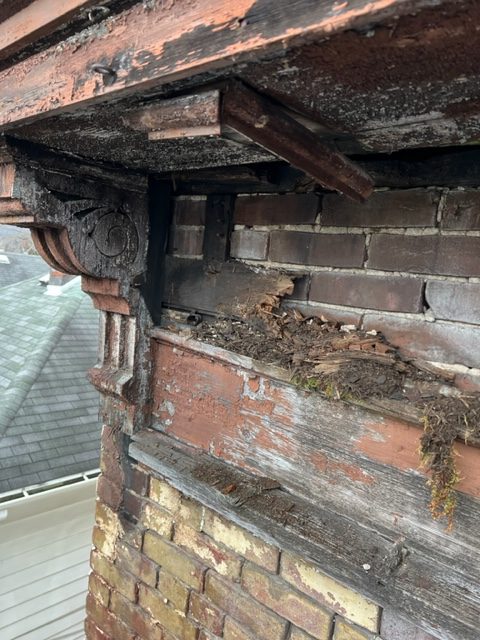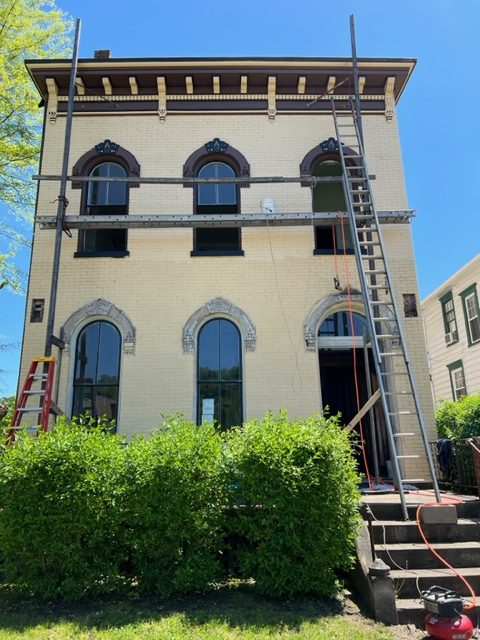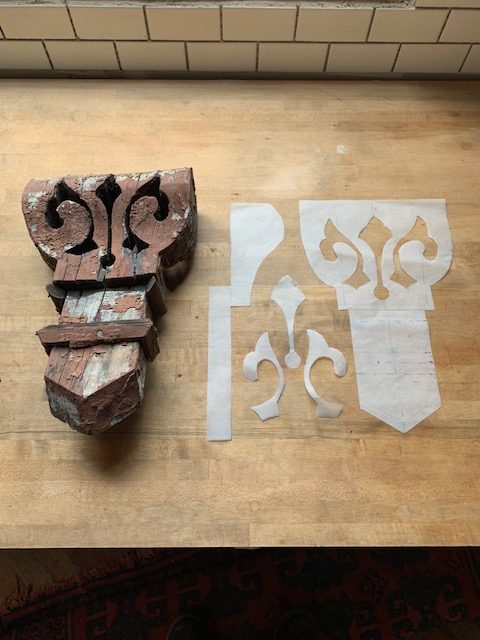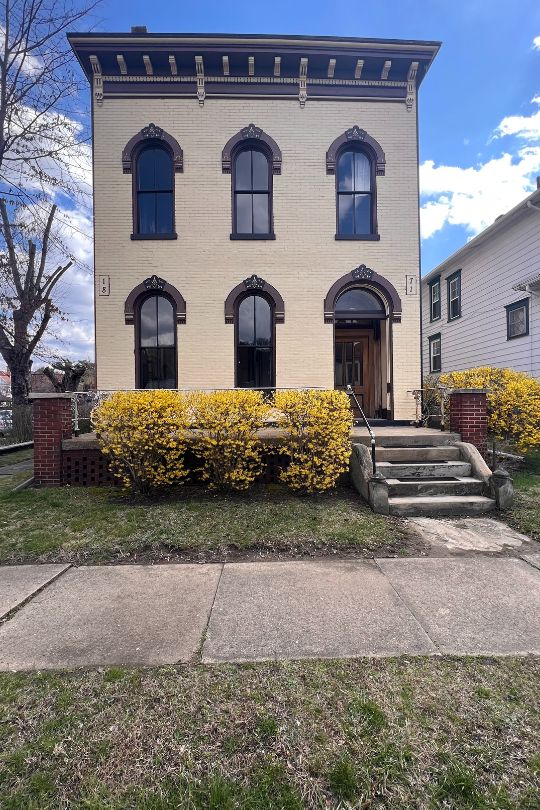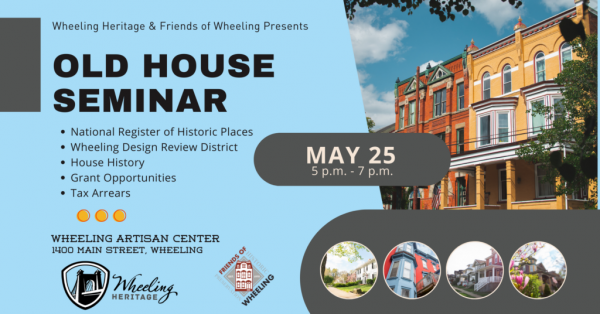Born and raised on Wheeling Island, Jason Bradcovich saw the house every day: a once-glorious example of Victorian-era architecture that was slowly crumbling after decades of neglect. He knew something had to be done, and that he was of the people who could do it.
“There’s something about these old buildings,” Jason tells me. “They just get under my skin. I want to get in there and do something.”
He knew could save Charles “Chris” Kraft’s house. He just needed the chance… and some help.
The Right Opportunity
Once Jason was ready to seriously pursue restoring this historic home, his first step was going online to figure out who owned the house. His numerous attempts at contact were met with a resounding silence.
“I thought that whoever owned it would maybe want to get rid of it, because it was a tax burden. I went to school for building preservation, so I knew the basics of how to acquire and fix up houses,” Jason said. “I found out who owned it, wrote him letters, and never got anything back. I kept my eye on the building though.”
Jason’s vigilance would pay off: one fateful day, an opportunity presented itself in the form of a state auction.
“The auction started at $1. I was sitting there and didn’t know how much I was going to bid on it, or how far I would go for it. For some reason, $200 popped into my head. I knew it was going to be worth AT LEAST that. When the auctioneer said $175, I said $200, and then it was sold.”
The Plot Twist
“I stayed for the rest of the auction,” Jason continues. “Afterwards, a city inspector handed me a piece of paper and said this house is going to come down.”
It turns out that after years of neglect, the house at 326 N. Huron Street was on the city’s Raze or Repair list. This obstacle did not deter Bradcovich.
“There was still time to not follow through on the purchase,” he says. “If I didn’t pay the $200, there was still time to back out. But I knew that house was worth saving.”
So, what do you do after you finally purchase the house you’ve been waiting to save, only to find out that it’s due to be torn down? You call a friend who also happens to have extensive knowledge and experience in restoration.
“That’s when I called Larry [Brothers],” Jason said. “I told him that I got a house and what happened with the city inspector, and he came over.”
Between Jason and Larry, they had the knowledge and skills to tackle the Kraft House. Jason Bradcovich is a graduate of the Belmont College Building Preservation and Restoration Program (BPR), where he not only learned the essentials, but also had the opportunity to get hands-on experience in the field by working with local craftsmen like Sarel Venter. In addition to wanting to take on the Kraft House, Jason is currently working on two additional properties – his home on Wheeling Island and a 4-unit property in Center Wheeling.
Larry’s career spans decades, beginning at age 12 working with a local contractor, then spending 5 years with the incomparable Bob Weir (another local skilled craftsman and devoted preservationist.) During that time Larry restored multiple Victorian houses before becoming head of maintenance at Sandscrest at Oglebay.
After making the call, Larry and Jason met at Kraft House later that day. Together they did a walk-through of the Kraft House, courtesy of an open window, and were pleasantly surprised at the condition. Larry was so enamored with the place he made a proposition.
“After we walked through he asked how much I paid for it,” Jason recounts. “I told him $200, and he said ‘Well, I’ve got $100’. We decided to go through with [the purchase].” And with that agreement began a nine-year journey working together to restore the Kraft House.
A Nine-Year Journey
It turns out that getting a house off the raze or repair list is no small feat, especially if it’s the oldest house on the list. In addition to the time spent restoring the property, Jason and Larry have also made several visits to court to make their case to keep the house from being demolished – a common occurrence when working with properties on the Raze or Repair list.
“We were immediately put on the vacant building registration. We had to check off all the boxes they gave us – foundation, windows, secure the building – in order to get off the list. The timelines they gave us were difficult to meet, because the code was not geared towards historic buildings.”
Even with the attention to detail and respect for the process of appropriate restoration, nine years seems like a very long time to fix a building. So I have to ask: “Why is it taking so long?”
“Well,” Jason begins, “this is mainly a passion project. We have other jobs, and then we work odd jobs to fund this project. We don’t have an unlimited budget. We’re just two guys doing weekend warrior work, doing the best with what we have.”
For the first eight years, Jason and Larry would check in with the court annually to keep them informed on the progress of Kraft House. The duo were able to submit for extended timelines through the court, but eventually, time began to run out and the deadlines were getting closer, the men had to go to court more frequently. And boxes needed to be checked off.
One major part of the checklist for the home was the issue of occupancy. Luckily, Jason knew just the trio to help out with that.
“I reached out to Jon [Smith] and let him know what was going on with the occupancy requirement,” Jason says. “And he said ‘Well, let’s get it occupied!” Jon is the owner of Smith Family Workshops, specializing in historic preservation and restoration. He’s an outspoken advocate for historic preservation and even serves on the Board of Directors for the Preservation Alliance of West Virginia.
Jon’s plan for fulfilling the occupancy requirement was to have local groups come in; the first would be his historical storytelling trio comprised of himself, Sarel Venter, and local metalworker Jeffrey Forrester. To be sure he got the full scope, he contacted one of the best in town when it comes to Wheeling history: Jeanne Feinstein, head of Friends of Wheeling – West Virginia’s oldest historic preservation organization.
“Jeanne cracked this open,” Jason says. “I got a call from her and she said ‘You’re not going to believe this’.
Jeanne’s discovery would pique interest and pull together a community of historians and preservationists to join in the fight to save 326 North Huron Street.
The Lost (Then Found) House of Charles “Chris” Kraft
“When Jeanne got involved, we were still going to court, still up to our noses in it,” Jason recounts. “When she sent over these documents I was shocked. I mean, I had heard of the guy [Charles “Chris” Kraft], but I just thought he had a planing business. I didn’t know he helped build Wheeling.”
Jeanne did her due diligence on the research of Chris Kraft, she found that prior to building the house at 326 North Huron St around 1878, Kraft was a German immigrant, arriving in the United States in 1834 at the age of 8. He later was a runaway and cabinet-making apprentice at age 13, then (reportedly) part of a Civil War militia that “helped to chase Morgan about Ohio”, before partnering with Bernhard Klieves and opening a shop of their own in 1864.
By 1868 they expanded their shop to include William Klieves and Theodore Klieves, engaging in the planing mill business under the moniker “Klieves & Kraft Company.” In 1890, Edgar W. Wells joined the firm as lead architect and designer. All things told, Klieves & Kraft were responsible for building notable Wheeling landmarks such as:
- St. Alphonsus Church in Centre Market
- Chapline Row
- The AW Paull House (which is now home to Jividen Law Offices)
- 96 12th St: The Kelly-Welty House
- 921 Main St: The Hazlett House (now HQ to Friends of Wheeling)
- 807 Main St: George E. Stifel’s Home (now Stifel-Kossuth House)
The group also built the iconic Second-Empire style Woodburn Hall, located at WVU in Morgantown, WV. This home served as inspiration for the house Kraft would build for himself and his family on Wheeling Island. The same home that Jason Bradcovich and Larry Brothers would purchase for $200.
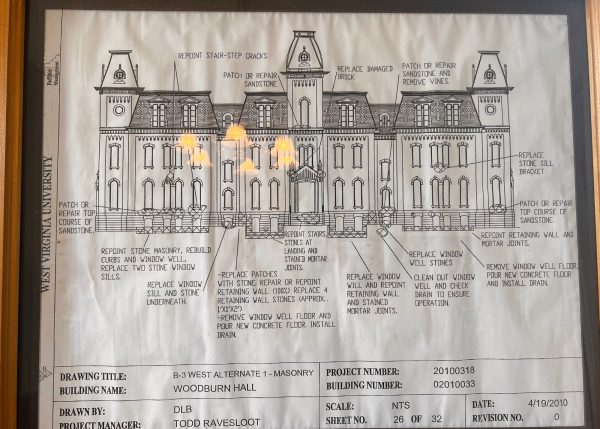
After Jeanne shared what she found with Jon, Jason, and Larry, the project took on a whole new momentum. The information began to spread throughout the community, and once the significance of the building became known, people became more invested in it.
Jon Smith stepped up in a big way to help fight the good fight for the Kraft House, and he also made some more serendipitous discoveries:
“While I was trying to figure out how to get [Kraft House] off the vacant build registry, I reached out to a woman who was part of my storytelling series for assistance. It turns out her great-grandfather was Kraft’s business partner, Klieves. And then we find out that Friends of Wheeling, who is helping us with this project, just so happens to be housed in a building that they built.”
In addition to hosting an event at the Kraft House in an attempt to prove the ability to occupy, Jon also appealed to the Preservation Alliance of West Virginia AmeriCorps to get the Kraft house listed on their Most Endangered Houses List. He began the process by getting letters of recommendation from Wheeling Heritage, Friends of Wheeling, and the Historic Landmark Commission. When he went to submit the application, he was told about the process, which required time. And time was something they didn’t have a lot of.
“I went to a Preservation Alliance committee meeting and plead my case. They told me I needed to submit paperwork, then the committee meets, and then the board will approve or deny,” Jon recalls. “I told them we were working on a tight deadline. And so they asked me to tell them about the house. Well, when I did that and they heard about the significance not only to Wheeling but to West Virginia as a whole, they decided to put it to a vote immediately.”
The vote to present to the board was unanimous, giving Jason and Larry some much-appreciated additional support. Jason, Larry, and the Kraft House now had a formidable list of supporters: PAWV, Wheeling Heritage, Jeanne Feinstein and Friends of Wheeling, Sarel Venter, Jeffrey Forrester, and Jon Smith.
It turns out this is more than a story about how two men bought a house for $200. This is a story about how a community worked together to preserve pieces of history.
The Kraft House Today
As of March 2023, after 9 years, the court case against the Kraft house was finally dismissed; Jason and Larry have completed a total restoration of front facade and first floor. The result is breathtaking.
Walking through, it is absolutely clear that a master architect designed this house. The visual beauty is what sealed the deal for Larry when it came to investing in the historic house.
“The architecture is what got me excited. The first thing I noticed when we came here the first time were the 10-foot doors. I have never been in a home, ever, that has 10-foot doors,” Larry says. The big old windows were cool. It was just beautiful. It was a place worth saving.”
Today, the Kraft House is finally open to the public, with the first floor ready to be rented out for private events: photoshoots, birthday or engagement parties, baby showers, murder-mystery dinner theater (Jon Smith swears the house is haunted; Jason says he hasn’t met a ghost, and Larry shrugged his shoulders in the most noncommittal way imaginable; I’m not sure who to believe).
The first floor is handicap accessible and up to code, there is space for outdoor entertaining and a kitchen area to accommodate outside catering and beverages. The second and third floors are currently not accessible, but that is subject to change.
“The plans keep evolving. We’re letting the house talk to us and tell us what she wants,” Jason tells me. “There’s a lot of listening in this line of work.”
To inquire or schedule an event at the Kraft House, please email Jason and Larry at thakrafthouse@gmail.com.
Ready to Take On Your Own Old House Project?
If you are thinking of taking on a project like the Kraft House, please read the following excerpt from my interview with Larry and Jason first.
Me, gesturing broadly at the house: “Would you do this again?”
Simultaneously: “No” “Yes”
“I’d do it again, but that’s because I’m a little crazy,” Jason said laughing. “I like the process. [Doing this] forces you into the moment. I love that. And that’s really what it’s all about. A project isn’t going to turn out well if you don’t enjoy the work.”
“I’ve been doing this my whole life,” Larry says. “I got my first job with a contractor when I was 12, and I’ve been in this line of work ever since. I’m ready to rest now.”
If you fall on the ‘Jason’ side of the fence, here are some helpful tips:
- If it’s a historic house, use historically appropriate approaches. It will be more expensive in the long run if you use new systems on old houses. Wheeling has several professionals who specialize in historic properties. Call them.
- There are federal, state, and local resources to help you complete your project. A good free catch-all resource is the Preservation Directory.
- Don’t be afraid to ask for help.
- Look into community resources, seminars, and workshops.
- The most important part: Enjoy the work.
If you’re ready to embark on your own historic restoration journey, then you are in luck! Friends of Wheeling and Wheeling Heritage are hosting an “Old House Seminar” that will share information and resources that are beneficial for current or aspiring residential property owners. The seminar will be held on Thursday, May 25 from 5 – 7 p.m. at the Wheeling Artisan Center. Learn more here.
I’m going to end this article with Jason and Larry’s sentiments because they really did say it best:
Beautiful things are worth saving. Our community is worth building up – it’s the right thing to do.

• Haley Steed has lived in Wheeling for the past 9 years. Before moving to Wheeling, she lived in Columbus, OH where she graduated with a BA in Comparative Cultural Studies from Ohio State University. Haley also earned an MS in Marketing and Communications from Franklin University. She has held multiple marketing positions for 10+ years, with experience in PR/media relations, internal communications, marketing campaign strategy + execution, SEO, branding, content creation, digital analytics, and graphic design. Haley currently serves as an AmeriCorp member at Wheeling Heritage. Haley has one human named Vida, two cats named Hank and Squigs McAllister, and is currently manifesting that her one-day husband’s name will be Jeffrey Goldblum.


